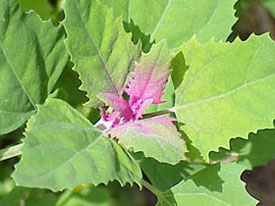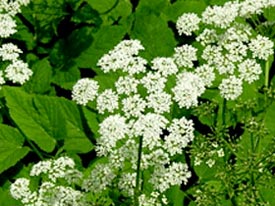
Young lambsquarters are relatively easy to pull and the leaves are edible.
Weeding is the main garden chore of summer. Like sweeping or vacuuming, it's a constant necessity that makes everything look better. If left unchecked, weeds can overwhelm garden plants. They reduce the beauty of ornamentals and the harvest of crops. Without weeding, gardens quickly turn into overgrown fields or messy lots.
Although chopping down that 40-foot Siberian elm and digging out the stump is a form of weeding, in this article I'm talking about weeding that can be accomplished with simple garden tools. Right now there's quack grass and goutweed and other fast growers that are shooting up overnight and requiring immediate attention.
Although weeds usually detract from the beauty of a garden, not all weeds are ugly. In April a patch of vibrant dandelions looks fantastic. For a burst of early spring yellow, experts recommend winter aconite, but it pales, literally, compared to a healthy dandelion with several fluffy, luminous flowers. Many other weeds have interesting structure or decorative foliage. I grew pokeweed as a woodland ornamental for years. Its purplish hue, ability to grow in the back of a shady border, and profusion of dark berries in October (relished by migrating birds) made it a favorite. But as weeds often do, it got out of control. The pokeweed grew to over 8 feet high and scores of seedlings began to pop up everywhere. To protect the integrity of the garden, the pokeweed had to go.
Weeding gives garden plants more light, water, nutrients, and space. Besides competing for resources, some weeds are allelopathic, which means they release chemicals into the root zone that inhibit the growth of neighboring plants. Weeds also attract and provide cover for pests like grasshoppers and aphids.
Some say it's paradoxical that gardeners who pamper plants and fawn over flowers can so easily destroy a weed. There are people (bless their souls) who advocate against using words like "weed" and "pest." I am not one of them. The definition of "weed" is subjective; any plant that is out of place or out of control can be weedy. Over the past couple of decades my garden weeds have included such prestigious plants as 'Annabelle' hydrangeas, bleeding hearts, daylilies, eastern wahoo, hellebores, Jack-in-the-pulpit, sage, Siberian squill, Solomon’s plume, tiger lilies, Virginia waterleaf, and woodland asters. If a plant sprouts or grows in the wrong area and upsets the intent and integrity of your garden, then feel free to treat it like a weed.

You can't let your guard down around goutweed.
Besides, weeding lets us unleash the more aggressive side of our personalities in a relatively benign, nonconfrontational manner. Weeding gives us a chance to flex our muscles. We don our fighting gear (old clothes, gloves, sunscreen, hat) and step out into the hostile, humid, hot arena that is our summer garden. After a few rounds of knocking out and piling up weeds, we can survey the altered landscape, declare victory (however temporary), and triumphantly return to the AC.
The grabbing, yanking, and snapping become part of a game. Pulling up a thistle or dandelion with most of the root attached is as gratifying as defeating a boss enemy on Zelda or using a seven-letter word in Scrabble. Conversely, breaking the stem off and leaving underground parts to resprout later is frustrating, like not being able to solve a few lines of a Sudoku puzzle.
The smaller the space, the easier the game, so for once, urban and small-space gardeners have an advantage over our suburban brethren. Despite over 60 containers, thwarting weeds on my rooftop and balcony is a snap. They have nowhere to hide once they sprout, and immigration by seed is limited. However, the ease of my rooftop container garden is balanced by the struggles in my community garden plot.
Community gardens are typically loaded with all the worst weeds. There is a seed bank several years strong. Wind, people (via potted plants and clothing), animals (droppings and fur), and birds (droppings) bring in loads of seeds. When I first cleared my plot in 1997, every shovelful of dirt contained hundreds of weed seeds and a handful of weedy stolons from creeping Charlie, johnsongrass, and bindweed. In such places it takes diligence to maintain order.
Tools help. The Cobrahead is the best weeding tool I have ever used. The curved head with the flat blade is comfortable and helps to pull up plants by the roots. The Circlehoe is another useful tool. Hand trowels are versatile enough to work as weeders, too. Pruners and loppers can halt large weeds like tree seedlings, pokeweed, ragweed, and burdock. But since the roots remain, many will simply resprout.
Lately I have been using the hoe more often. It’s gentle on the back and perfect for crops or other plants arranged in rows. When you have a nearly endless seed bank of weeds, removing them individually is not always practical. The hoe can quickly chop down a swath of unwanted seedlings. Like cutting, hoeing established weeds may not kill them, but at least they will be stifled for a while.
But tools are not required for weeding effectively. Hand-pulling is actually my preferred method for removing larger weeds. Proper tension must be maintained throughout the pull. Too much, too fast, and the stem snaps, leaving the roots to resprout. To remove more of the underground portion, get a secure grip on the base of the weed with as many leaves and stems as you can hold. Begin to pull slowly as you feel for maximum resistance. Exert increasing force on the roots by pulling in a straight line. You will start hearing the familiar crackling of popping roots.
It’s a tricky balance. Once one root pops, you may have to reduce or increase the tension to get the next one. After a few weeding sessions, intuition takes over and your hands will be able to feel the strain on the roots. (I never realized all the processing and adjustments inherent in simply pulling a weed until I tried to describe it.)
For runners and creeping rhizomes, a delicate hand is required. Pulling weeds like apple mint, goldenrod, and Johnsongrass is similar to pulling keys up from a manhole with a string and paperclip. Go slow and constantly shift your grip, hand over hand, to remove as much of the runner as possible. Jerking the stolons can break them into many viable pieces that will haunt you a few weeks later.
Although a difficult task, especially under the angry July sun, weeding can be relaxing and almost therapeutic. After a long day, weeding helps me unwind. My mind can rest as my fingers move throughout the garden. They subconsciously know when and how to lift the stems of creeping Charlie off the ground, or to carefully but firmly grip the spiny stem of sow thistle, or to deftly twine the stems of bindweed for added leverage.
Because weeding has become intuitive, my mind wanders as I work. Some of my most creative thoughts and plans arise while weeding (unfortunately, I rarely write them down and typically forget them until my next weeding session). It's also a time for reflecting on the past. Weeding is one of those gardening tasks that connect us to our forefathers. I imagine Abel out tending his fields with a primitive stick-and-stone hoe. While he was chopping away at oxalis, witchweed, and thistle, Abel undoubtedly planned his harvest, thought of new gardening techniques, and probably thought of a few expletives for his parents for getting them thrown out of Eden. (He should have been developing schematics for a bludgeon-proof helmet.)
To maintain their integrity and function, all gardens must be weeded. Agricultural fields, ornamental gardens, restored habitats, and even wilderness areas are invaded by weeds. They are the ultimate opportunists, requiring human disturbance to introduce them, but little else to help them establish. So although weeding can be sweaty, tiring, prickly, mosquitoey work, it is worth it to protect our gardens and free our minds.
Now, go get 'em!